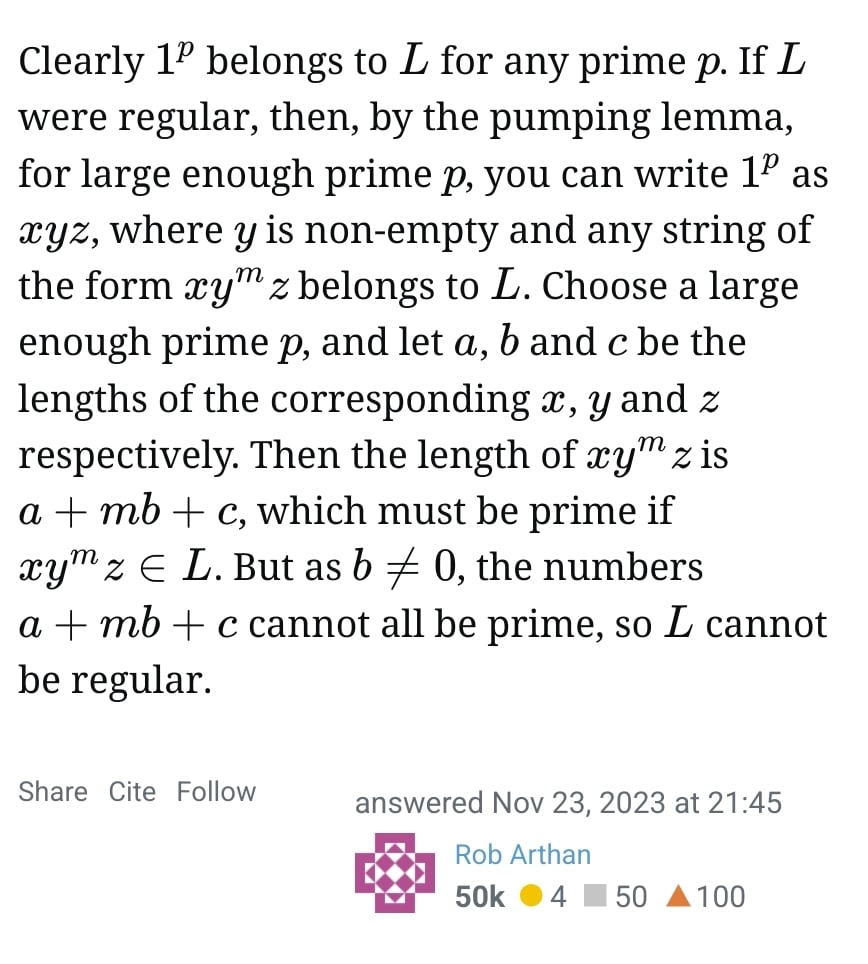

You got downvoted here but you’re absolutely right. It’s easy to prove that the set of strings with prime length is not a regular language using the pumping lemma for regular languages. And in typical StackExchange fashion, someone’s already done it.
Here’s their proof.
Claim 1: The language consisting of the character 1 repeated a prime number of times is not regular.

A further argument to justify your claim—
Claim 2: If the language described in Claim 1 is not regular, then the language consisting of the character 1 repeated a composite number of times is not regular.
Proof: Suppose the language described in Claim 2 is regular if the language described in Claim 1 is not. Then there must exist a finite-state automaton A that recognises it. If we create a new finite-state automaton B which (1) checks whether the string has length 1 and rejects it, and (2) then passes the string to automaton A and rejects when automaton A accepts and accepts when automaton A rejects, then we can see that automaton B accepts the set of all strings of non-composite length that are not of length 1, i.e. the set of all strings of prime length. But since the language consisting of all strings of prime length is non-regular, there cannot exist such an automaton. Therefore, the assumption that the language described in Claim 2 being regular is false.
An LLM (large language model, a.k.a. an AI whose output is natural language text based on a natural language text prompt) is useful for the tasks when you’re okay with 90% accuracy generated at 10% of the cost and 1,000% faster. And where the output will solely be used in-house by yourself and not served to other people. For example, if your goal is to generate an abstract for a paper you’ve written, AI might be the way to go since it turns a writing problem into a proofreading problem.
The Google Search LLM which summarises search results is good enough for most purposes. I wouldn’t rely on it for in-depth research but like I said, it’s 90% accurate and 1,000% faster. You just have to be mindful of this limitation.
I don’t personally like interacting with customer service LLMs because they can only serve up help articles from the company’s help pages, but they are still remarkably good at that task. I don’t need help pages because the reason I’m contacting customer service to begin with is because I couldn’t find the solution using the help pages. It doesn’t help me, but it will no doubt help plenty of other people whose first instinct is not to read the f***ing manual. Of course, I’m not going to pretend customer service LLMs are perfect. In fact, the most common problem with them seems to be that they go “off the script” and hallucinate solutions that obviously don’t work, or pretend that they’ve scheduled a callback with a human when you request it, but they actually haven’t. This is a really common problem with any sort of LLM.
At the same time, if you try to serve content generated by an LLM and then present it as anything of higher quality than it actually is, customers immediately detest it. Most LLM writing is of pretty low quality anyway and sounds formulaic, because to an extent, it was generated by a formula.
Consumers don’t like being tricked, and especially when it comes to creative content, I think that most people appreciate the human effort that goes into creating it. In that sense, serving AI content is synonymous with a lack of effort and laziness on the part of whoever decided to put that AI there.
But yeah, for a specific subset of limited use cases, LLMs can indeed be a good tool. They aren’t good enough to replace humans, but they can certainly help humans and reduce the amount of human workload needed.